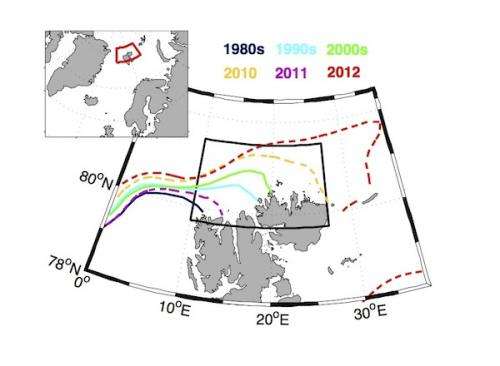Large sea ice changes North of Swalbard

During the last decades warmer Atlantic water has caused a retreat of the ice edge north of Svalbard. In contrast to other areas of the Arctic Ocean, the largest ice loss north of Svalbard occurred during winter.
A paper published in Tellus by Ingrid Husøy Onarheim and co-workers demonstrates large changes in the sea ice cover north of Svalbard. The Arctic sea ice area has been measured, using satellites, since 1979.
The new study shows that the ice cover north of Svalbard is decreasing for all months, with largest ice reduction during winter. This is in contrast to the observed changes in more central parts of the Arctic Ocean, where largest ice decline is happening during summer.
Warmer Atlantic water during the last decades
Warm and saline water from the Atlantic dominates the area west of Svalbard. Parts of the warm water continue northwards, transporting heat towards the Arctic Ocean. In the opposite direction, winds drive sea ice from the Arctic Ocean into the area. As the warm water from the south encounters the sea ice from the north, the oceanic heat both melts the ice from below and inhibits ice growth during winter.
The study shows that the sea ice has retreated above the pathway of the Atlantic water north of Svalbard. This indicates a direct influence from the Atlantic water on the sea ice conditions. Observations of the Atlantic water temperature show a gradual warming during the last decades. Hence, there is more available heat for melting sea ice, and it is also more difficult to grow sea ice because the ocean needs more cooling to reach the freezing point.
The ice area continues to decrease
The results indicate that the extra oceanic heat has been the major driver of the sea ice loss, but it has also contributed to higher air temperatures in the area; larger open-water areas cause larger heat transfer from the warm ocean to the cold atmosphere. The long-term changes in the ice cover north of Svalbard are not related to winds, but the wind influences the year-to-year variability of the ice conditions.
The long-term prospect for the Arctic wide sea ice cover is a further reduction during summer. It is anyway difficult to come up with future predictions for the ice conditions in the area north of Svalbard. The temperature of the Atlantic water has decreased during the last years, which could suggest a recovery of the ice cover here. However, the Arctic sea ice thickness is reduced, meaning that less oceanic heat is needed to melt the ice.
In order to determine the dominating driver of the two, more advanced climate models coupled with observations are needed. Studies and modeling activities at the Bjerknes Centre in Bergen will investigate this further.
More information: Onarheim, I. H., L. H. Smedsrud, R. B. Ingvaldsen, F. Nilsen. 2014. "Loss of sea ice during winter north of Svalbard." Tellus A 2014, 66, 23933. dx.doi.org/10.3402/tellusa.v66.23933
Provided by University of Bergen


















